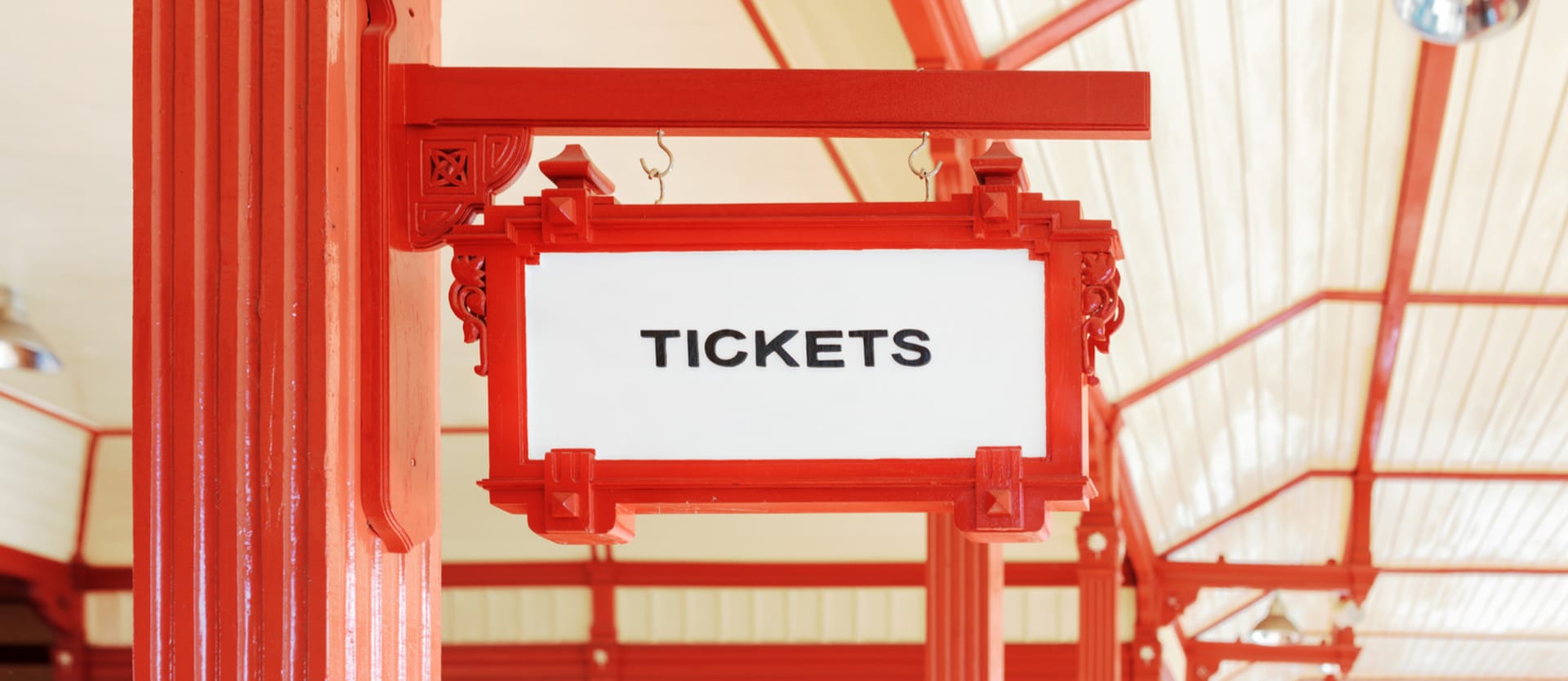Train travel is in a disadvantaged position in our world. After dominating transport for over 100 years, railways are no longer competitive with air travel. And if the fairness of this comparison concerns you, all you have to do is consider how expectations for purchasing railway tickets were influenced by the way we purchase airline tickets.
One of the most interesting differences between how air and train transport operate is the role technology has in each. Airlines rely on their IT systems, investing in innovations to compete and survive. Railways don’t view IT as a strategic success factor since it’s often unclear what and why should be innovated. The market is less competitive, so operators take longer to keep up with the trend. This results in an unsatisfying and confusing shopping experience for passengers and stagnant growth for providers.
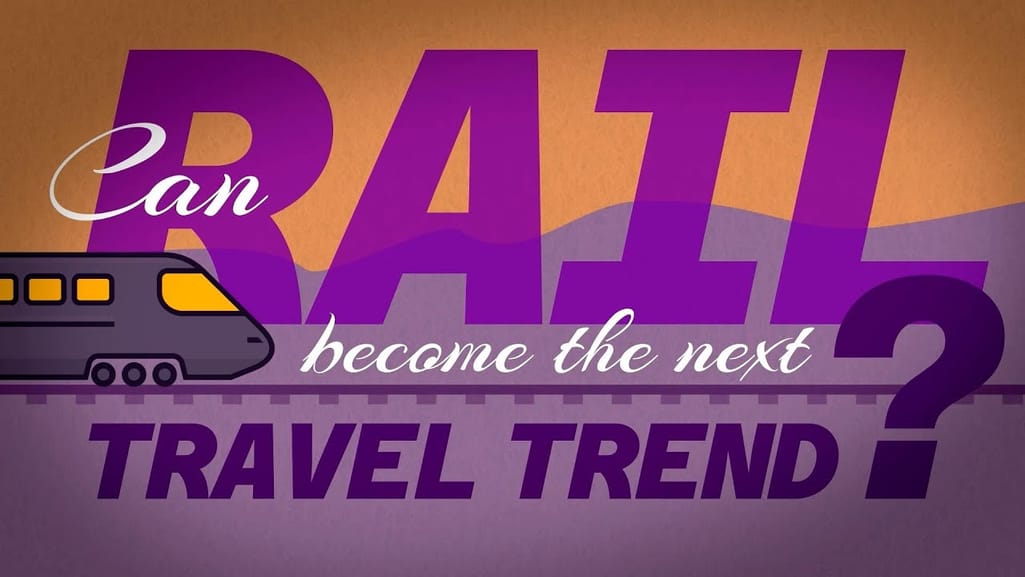

Learn more about train travel
In this article, we want to tackle just that and explain how a modern railway reservation and ticketing system can be advantageous to providers, travelers, and the whole train travel industry.The current state of railway reservation technology
Unfortunately, railways are not integrated into the travel ecosystem as airlines, hotels, rental cars, or even cruises are. Visit some of the largest online travel agencies such as Expedia or Booking.com that dominate travel distribution on the web and you won’t find rail reservations in them. Of course, there are specialized OTAs like Trainline, but this only further isolates the passenger rail industry from the rest of the travel providers. Let’s analyze why this happens and what those differences are.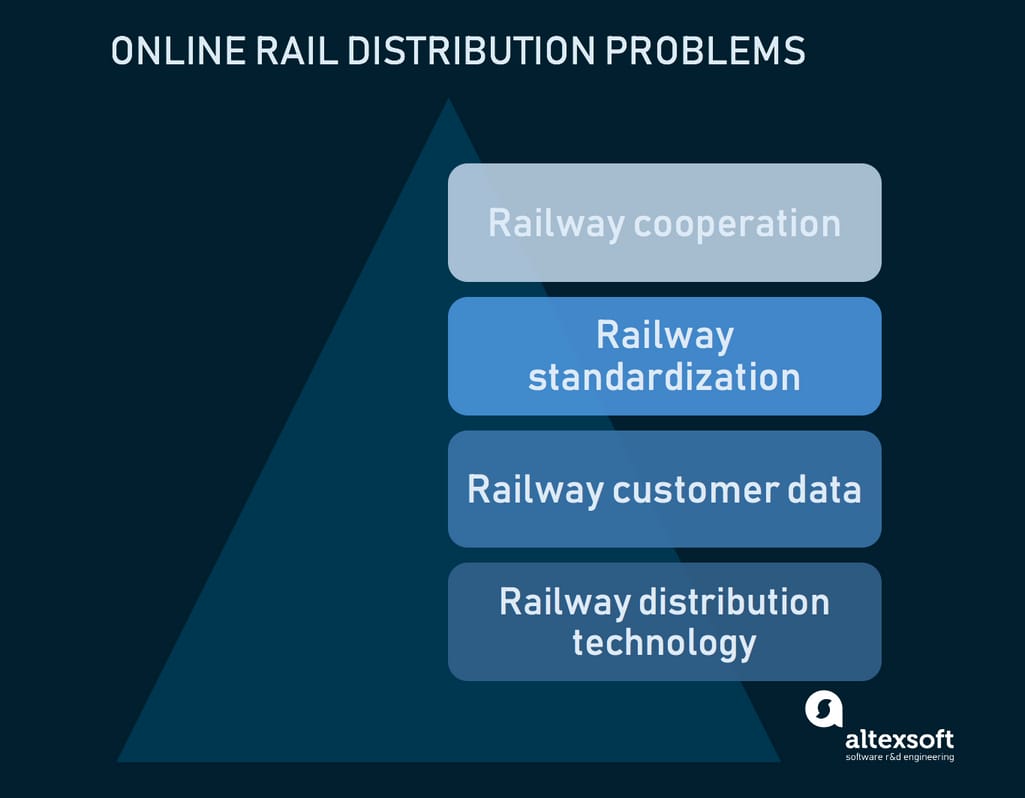
The bottom-up nature of rail distribution problems
Lack of railway cooperation. Buying a ticket for a connecting flight is easy. Airlines have interlining agreements with each other allowing passengers to seamlessly travel several flights, checking in once and getting rebooked in case of disruption. The lack of similar alliances among railways leads to less competition, lower passenger volumes, and minimal cross-border traveling.Lack of standardization. Data sharing, which is the holy grail of travel distribution, is only possible when all systems operate in the similar way and use the same business logic, data format, and data exchange technologies. Airline technology, for example, was spawned from a single booking system -- Sabre. Train technology didn’t follow the same evolution path, which created different approaches, processes, and products. As a result, even global distribution systems (GDSs) that power the largest network of travel providers have no more than 50 railway operators signed in.
Lack of customer data. Rail operators don’t know their customers. Because of the sporadic nature of train ticket shopping (people can purchase tickets online, in a kiosk at the station, or even on-board), you can’t create a holistic overview of your customers. This means that companies target a very generalized impression of a user and can’t accurately segment users and price their offers.
Legacy technology. Legacy systems are the bane of their existence for many traditional industries, railway included. They’re typically developed with outdated technology that has many limitations in today’s world; are expensive to manage and maintain, inclining developers to use workarounds and hacks to keep it alive; not developed from scratch, for example by customizing an airline reservation system; and bespoke, which creates inconsistency and stalls system-to-system connectivity.
Three of these problems (standardization, customer data, and technology) can be approached by implementing a modern, advanced rail reservation system. The fourth one (cooperation) will follow when you have the base for it. Let’s continue by examining what functions such a system will perform.
Features of a railway reservation system
A railway reservation system is software that handles distribution, pricing, scheduling, and other railway operations. Most providers have some of these functions digitized, but as we mentioned, this is done sporadically. We want to talk about four main modules of reservation systems and cover extra integrations to be on the lookout for.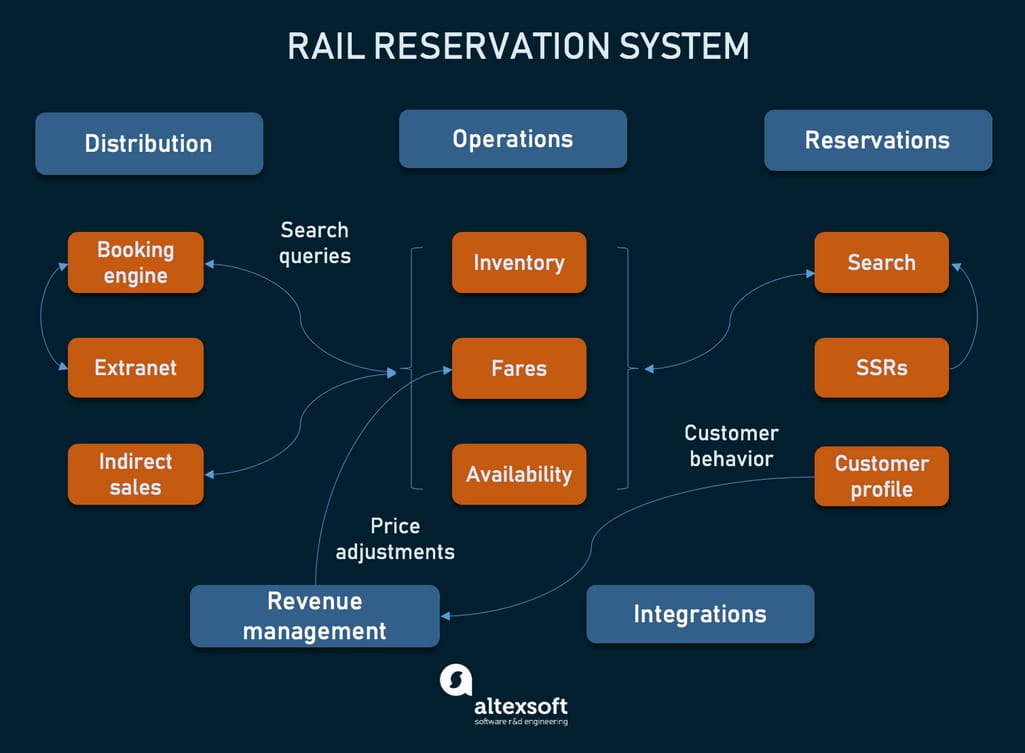 Rail reservation system modules and their connections
Rail reservation system modules and their connections
Multi-channel distribution
One of the largest problems of legacy reservation systems is complicated ticket distribution or even a lack of it in some of its forms. Railways can distribute train seats directly and indirectly. Direct channels include:- an eCommerce website/app,
- a kiosk or a ticket machine at the railway station,
- on-board point-of-sale devices.
- traditional travel agencies,
- online travel agencies,
- travel management companies,
- traditional ticket booth at the railway station.
Train booking engine. An internet booking engine is a piece of software that receives customer search requests and then returns appropriate results from its inventory. Somewhere in the middle of the process, the engine can also apply custom business rules to prioritize how search results are displayed or package several services into a single offer, which increases sales. Booking engines are used on a railway operator’s website and an app and can also surface in different types. For example, you can have a separate engine for corporate clients and distributors. In this case, they are usually accessed via an extranet.
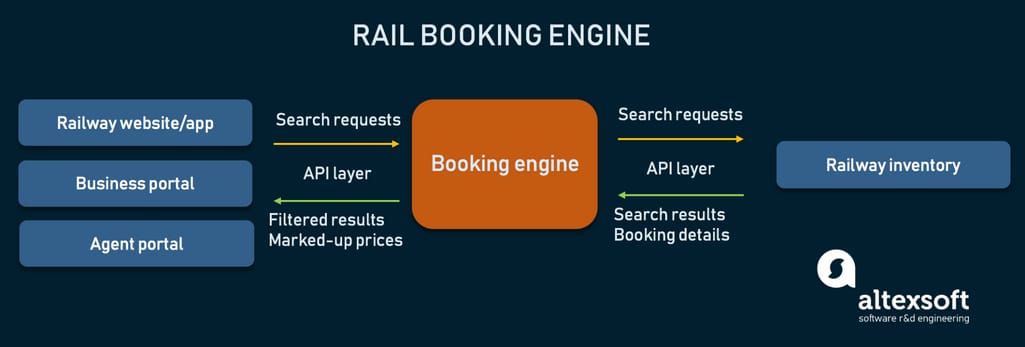 The process behind a rail booking engine
The process behind a rail booking engine
API connections. The Application Programming Interface (API) technology is a standard system-to-system communication method in the travel industry and beyond. That’s how a railway provider can send their inventory data to GDSs, OTAs, and TMCs for indirect distribution. This can be a great way to increase bookings since only a handful of big operators provide railway APIs and it will allow distributors to easily establish access to your inventory.
Rail operations
A rail reservation system is called reservation because it mostly concerns the tasks of distribution and booking, so workforce management and route modeling, for example, are covered separately. But depending on the tool, you can stash all of those features under one roof. Let’s go through them.Inventory management. The system keeps track of availability by importing data not only from all distribution channels but also from handheld readers in trains. This automation eliminates mistakes with overbooking or seat allocation.
Fares and pricing generation. All product offerings, discounts, and base prices are configured here. One of the more advanced features -- dynamic pricing -- helps adjust the price depending on demand forecast and other factors. We will touch on that in detail covering the revenue management module.
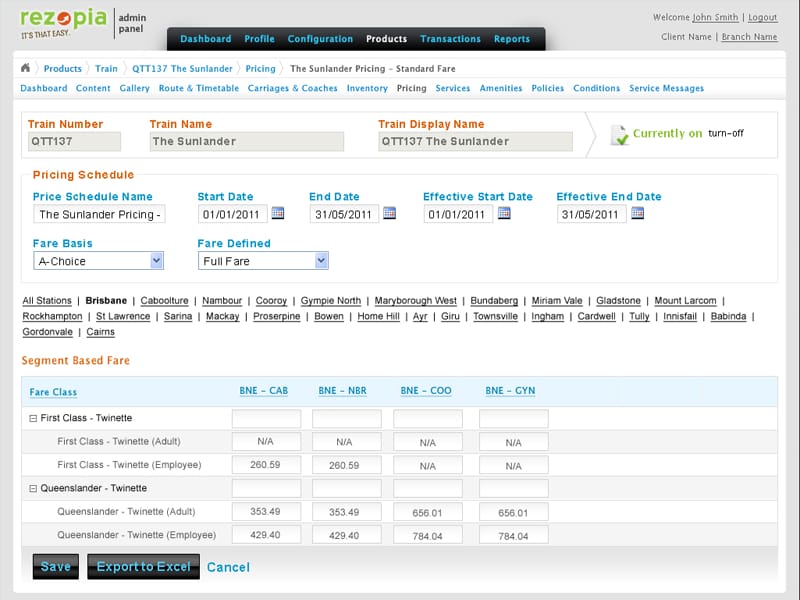 Pricing dashboard in Rezopia
Source: Sonata Software
Pricing dashboard in Rezopia
Source: Sonata Software
Information sharing. There are two types of information a railway operator should provide passengers with. First is disruption information about the schedule changes or interruptions. It’s usually performed by posting updates on information displays at the station (in web or GTFS form) or as notifications (SMS, email, in-app, etc.) The second type is real-time passenger information (RTPI) that uses GPS tracking to publish the position of the vehicle or delays that are calculated automatically.
Disruption management. When railway disruption happens, there are three main problems operators need to adjust: the timetable, the crew, and the rolling stock. These arrangements are usually done manually, so the system should at least be able to provide tools for that. For example, an operator should have an overview of vehicles on standby and easily filter the ones with the needed capacity. For a broader understanding of how disruptions are handled, read our article on airline disruption management.
Reservation and ticketing
Railway transport considers the processes of ticketing and reservation to be one and the same since there’s no delay or distinction between booking and getting a train ticket, unlike in air transport. Ticketing functionality covers customer-facing features that make it convenient for customers to choose, pay for, use, and print tickets. Some of the most crucial ticketing implementations in a modern reservation platform include the following.Advanced search capabilities. One of the biggest trends in travel sales today is providing capabilities not only for searching for a relevant option but helping customers plan their whole journey on your platform. Such a system collects more information about the customer to tailor results to their individual needs. This can be achieved using rules (for example, showing the fastest routes for customers who checked the “traveling on business” box) or smart algorithms that collect explicit and implicit data to make best-fit offers.
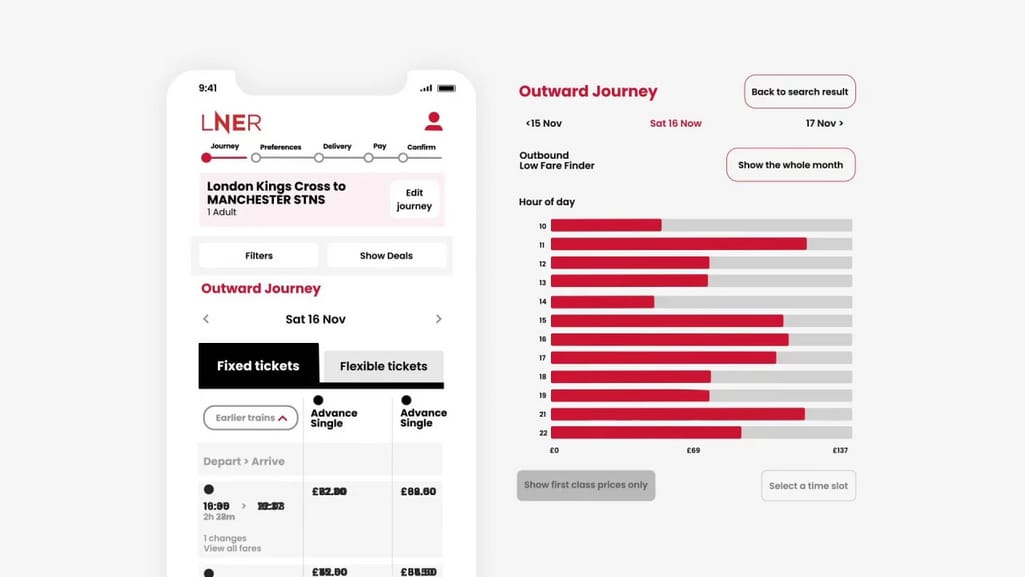 LNER provides convenient journey planning flow
Source: Silverrail
LNER provides convenient journey planning flow
Source: Silverrail
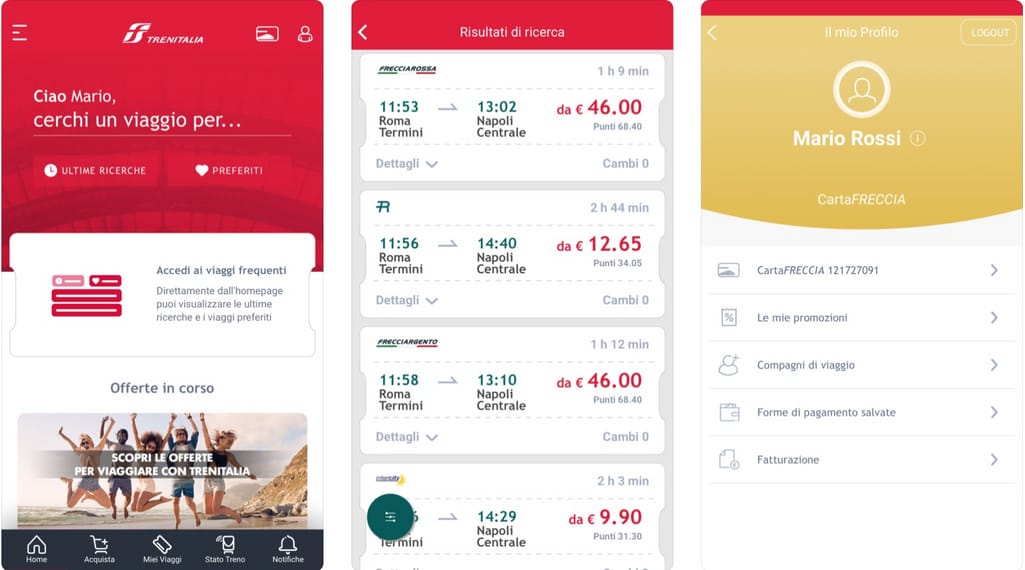 Customer profile on the Trenitalia app allows users to view their promotions and invoices, save the payment method, and many more
Source: Trenitalia
Customer profile on the Trenitalia app allows users to view their promotions and invoices, save the payment method, and many more
Source: Trenitalia
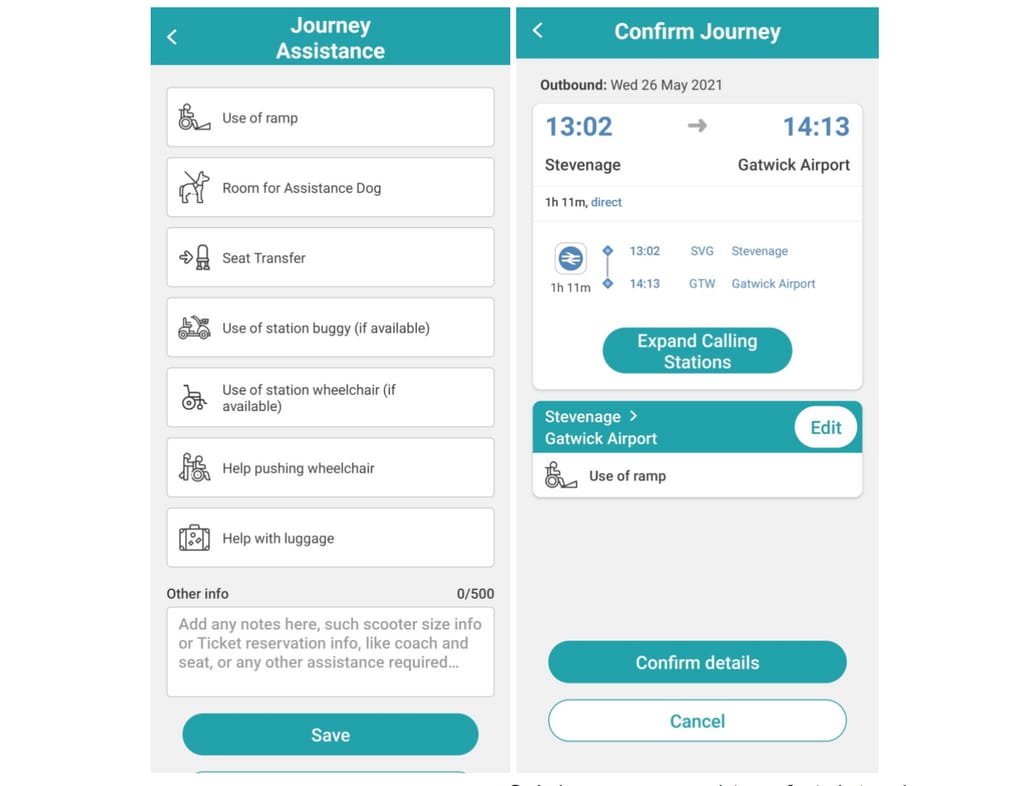 Ordering passenger assistance for train travelers
Source: Gatwick airport
Ordering passenger assistance for train travelers
Source: Gatwick airport
- loyalty program design,
- multi-language and multi-currency support,
- seat maps,
- email, SMS, or in-app notifications,
- multiple payment options integration,
- easy rebooking and cancellation capabilities,
- automated refunds.
Revenue management and ancillary revenue
Revenue management (RM) is a collection of techniques for increasing income by controlling the availability and the price of products. Actively applied in airline and hotel businesses, it can be just as successfully implemented for rail operators. Though research in this area is still limited and implementations are derived from other industries, there are successful examples and existing solutions that provide revenue optimization for passenger rail.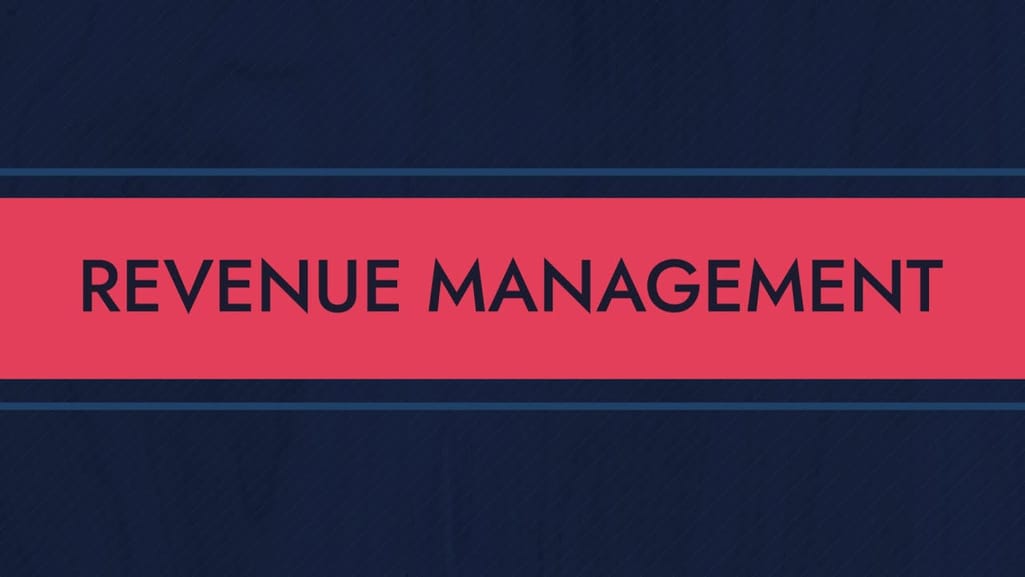

Watch our video to learn about revenue management in under 8 minutes
Demand forecasting. RM decisions are heavily based on demand forecasts, which are compiled from the historical purchase data and information about customer behavior and purchasing preferences. Although operators are making demand forecasts all the time, the advanced techniques that deliver the most accurate forecasts are made by applying predictive analytics -- a machine learning approach.Price sensitivity analysis. Passengers’ sensitivity to price is one of the main parameters for segmenting your customers (into Economy and Business classes, for example) and adjusting prices according to those segments. Price sensitivity analysis, just like demand forecasting, should automatically be updated as you collect more customer behavior data.
Automated pricing. All this analysis allows the system to adjust pricing automatically for most of the journeys.
Integration capabilities
In a perfect world, you could get a reservation system out of the box, install it, and use it from the ground up. Many providers try to support this thinking, ensuring their customers that one solution will fix it all. But in real life, adopting a new system usually comes with a few caveats.- Data transmission. You’re probably already keeping your customer or financial data in specialized software. Integrating data into a new system that works differently and will take time to learn is not very efficient.
- Lack of functionality. You won’t be able to find a system that ticks all the boxes, especially in the rail industry that doesn’t have a big choice of providers.
- Standard functionality. Even if there’s a reporting module, it might be too lacking in features to satisfy your needs since providers can’t be specialized in all business operations equally.
- Uncertainty about the future. You can’t be sure of what features will matter to you in a year or so, but you need software now, so it’s a daunting choice.
CRM and marketing tools. If you’re already using a popular CRM tool by Salesforce or HubSpot, look at solutions that can seamlessly synchronize with them and import data via established connection. CRM tools allow you to collect passenger accounts and identify them as loyal, create marketing campaigns, configure agreements, limits, and discounts.
Accounting tools. There are much better and specialized options than those provided by rail reservation systems. Although there are usually internal capabilities for invoice generation, payment reconciliation, and basic account payables/receivables tracking, you’ll likely gain more value from QuickBooks or other popular tools.
Reporting and BI tools. There are basic standardized reports offering daily sales, operational reports, and tracking of other common activities. They bring some value, but in terms of advanced technology that can be used for revenue management, consider Business Intelligence tools. Products like Sisense and Tableau take into account data from a huge number of sources and are ultimately used to aid in decision-making.
Implementing a rail reservation system
If we look at the systems that railway companies are already using, we’ll see that reservation technologies can be roughly divided into two categories.Custom-build systems, created from the ground up either with the provider’s own technical effort or by employing a tech partner. This was Deutsche Bahn’s experience with Amadeus, for example. A more expensive, complex, and time-consuming method, it also allows you to perfectly match your expectations with a finished product and ensure any integration requirements are met.
Prebuild modular systems, where an operator purchases a finished solution, for example, the way Eurostar employed S3 Passenger. With faster time to market and lower investments, you will get the system running in no time, but first, you’d have to consider all the options. In the end, you will still need to make adjustments and perhaps custom integrations, too.
Both scenarios are valid. And since the rail technology market is so small, they sometimes merge together with a system provider also offering customization. And there’s also an issue of digital transformation if you’re migrating from a legacy tool. Here, your main problem would be not finding a good system, but finding a good technology partner who will help you make those important decisions and will guide you whichever approach you choose.
Considering all that, we want to leave you with an overview of a few reservation providers to help you cement your vision of the system you want to implement. While we’re not promoting any of the providers, we believe that the examples will be useful.
S3 Passenger by Sqills
Sqills is a focused provider of public transport technology including to rail and bus operators. Recently acquired by Siemens Mobility, it’s offering its software suite to such providers as Britain’s RDG, Canada’s VIA Rail, France’s TER, and other well-known names. Their main product S3 Passenger is a SaaS tool for creating a customer-centric booking flow with API-supported distribution.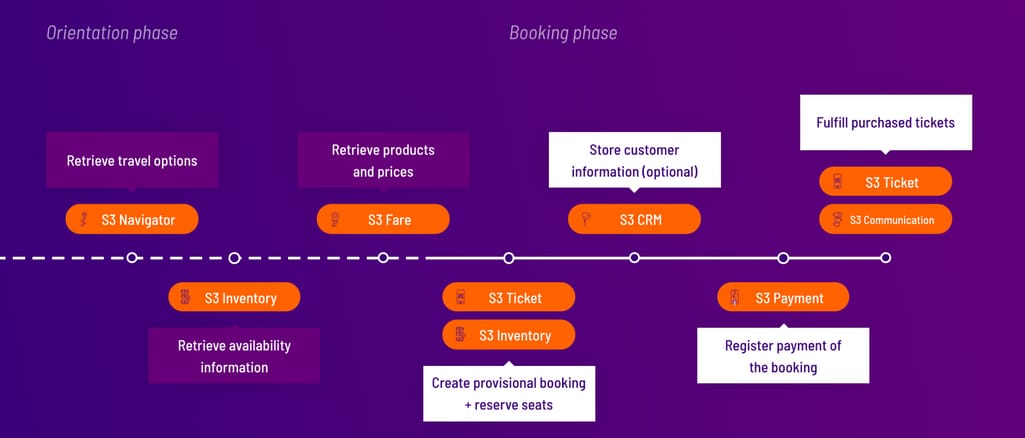 S3 Passenger modules
S3 Passenger modules
SilverRail
SilverRail has a solid foundation in the travel distribution ecosystem. In 2017, Expedia bought a 70 percent stake in the company seeing it as an important component in growing their rail distribution. But when the management changed, Expedia’s priorities shifted and SilverRail was sold back to its management. Still, these days, SilverRail operates as a rail aggregator and powers business rail bookings on Egencia, among the others.Apart from that, SilverRail offers modular solutions to rail operators, which include:
- search and journey planning,
- ticket issuing,
- distribution,
- fulfillment,
- customer service,
- data insight.
TurnIt Ride
TurnIt is an Estonian provider of reservation and inventory management solutions for bus and rail companies. Their product Turnit Ride is an end-to-end modular system that provides:- distribution via web, mobile, on-board devices, kiosks, agent portal, GDSs, and OTAs;
- passenger information sharing through real-time info displays and notifications;
- marketing capabilities with discount management, campaigns, and loyalty programs;
- logistics management powering routing and interconnections;
- inventory management and fleet profiles and their capacities;
- operations configuration including asset and crew management;
- SOAP and REST APIs for seamless integrations.
Rezopia by Sonata Software
Rezopia is a cloud travel platform that provides end-to-end reservations, operations, and distribution of travel offers. Although it also covers air travel and tour operators, the product has a rail-specific operations module, which includes:- Train Schedule Creation
- Carriage Consist and Configuration Management
- Inventory and Yield Management
- Fares and Pricing
- Dynamic Pricing Rules
- Manage Discounts, Concessions and Promotions
- Seat Optimization Rules
- Disruption Management
- Payment, Cancellation and Modification Policies
Increasing rail exposure
The ultimate goal is to help customers find train tickets. And sometimes, rail carriers need to take small steps to make it happen because some of the issues are more prosaic than we’re used to dealing with.One final distinction between air and train travel is how it deals with state borders. Air transport has been inherently international and you can freely purchase a ticket to Australia from Belgium, for example. Websites are multilingual and you can usually switch to your local currency. Moreover, you would never have a problem paying with your preferred credit card.
At the same time, getting a train ticket to travel across Poland, which is far closer to Belgium than Australia, might pose a problem: Some providers don’t even take foreign credit cards, and you’d have to maneuver around Google Translator to make sure you grasp all important information.
Localizing your content language, currencies, and payment systems will elevate the quality of rail shopping and drive sales exponentially.

Maryna is a passionate writer with a talent for simplifying complex topics for readers of all backgrounds. With 7 years of experience writing about travel technology, she is well-versed in the field. Outside of her professional writing, she enjoys reading, video games, and fashion.
Want to write an article for our blog? Read our requirements and guidelines to become a contributor.
